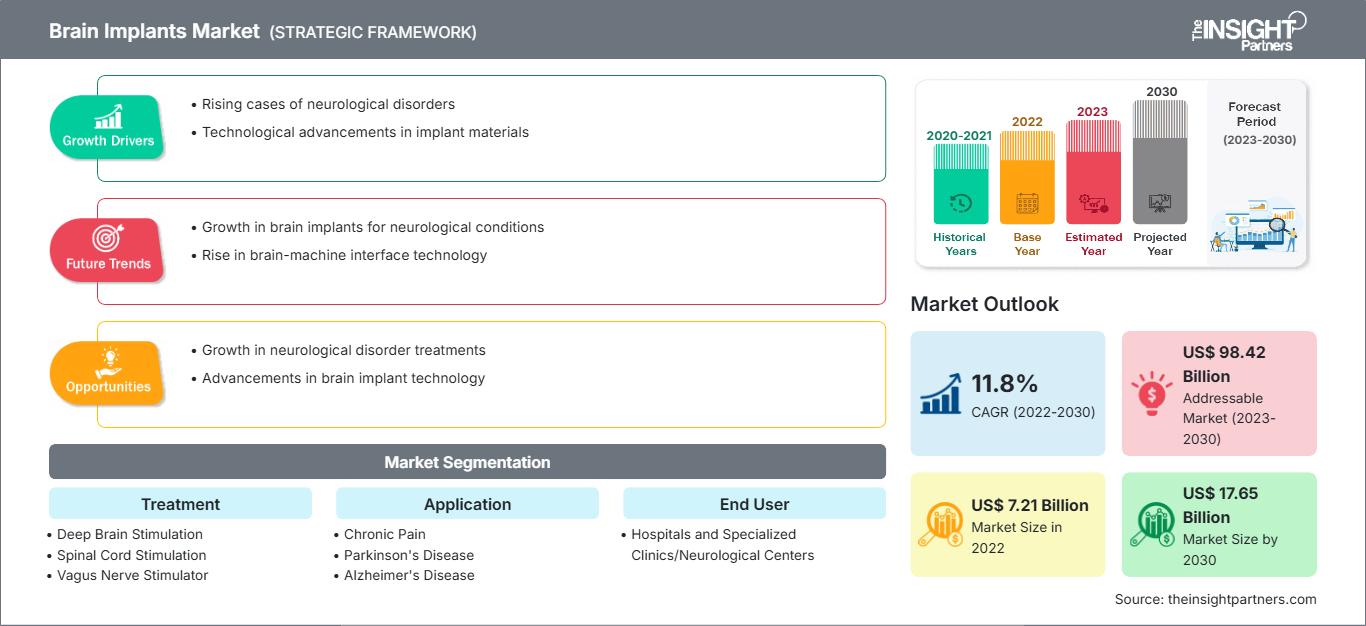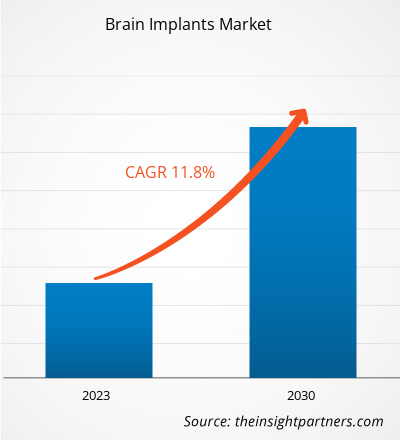[研究报告] 预计脑植入物市场规模将从2022年的72.058亿美元增长到2030年的176.4765亿美元;预计2022-2030年期间的复合年增长率为11.8%。
市场洞察与分析师观点:
神经科学和神经技术正在迅速发展,随着帕金森病、阿尔茨海默病和癫痫等神经系统疾病的日益普遍,医学科学正不断突破新的极限。脑植入物通过改变神经活动和恢复正常脑功能,提供了潜在的治疗方案。此外,人们越来越意识到脑植入物的优势。深部脑刺激作为一种安全且行之有效的帕金森病治疗方法,越来越受到人们的信赖,这为脑植入物市场创造了增长机会。随着大量神经植入物的引入和使用,以帮助改善记忆力、治疗疾病和假肢通信以有效缓解脑相关疾病的症状,预计未来几年市场将进一步增长。
增长动力:
随着年龄的增长,老年人可能会患上影响其行动能力的神经系统疾病。阿尔茨海默病、癫痫、帕金森病 (PD) 和肌张力障碍是影响老年人群的最常见的神经系统疾病。根据美国人口普查局 2020 年人口统计数据,老年人口达到 5580 万,占全国人口的 16.8%; 2020 年,巴西近六分之一的人口年龄在 65 岁及以上。此外,根据泛美卫生组织 (PAHO) 的数据,巴西 60 岁及以上人口约为 3000 万(占该国人口的 13%)。预计到 2030 年,这个年龄段的人口将达到约 5000 万(占总人口的 24%)。根据 UpToDate Inc. 2021 年 8 月发表的一篇文章,癫痫发病率随年龄增长而上升,75 岁及以上患者发病率最高。
美国和加拿大等国家,运动障碍和精神疾病的患病率很高,而且老年人口不断增长。根据帕金森基金会的数据,帕金森症状在平均 60 岁时很常见。例如,每年约有 9 万美国人被诊断出患有 PD。该组织还指出,PD 的发病率随着年龄的增长而增加;美国有近100万人患有帕金森病,预计到2030年这一数字将达到120万。根据2023年4月发表的一篇题为《阿尔茨海默病:深部脑刺激能帮助缓解症状吗?》的文章,全球约有3200万人患有阿尔茨海默病。根据BrightFocus基金会2022年10月发布的《阿尔茨海默病研究情况说明书》,2022年美国新增阿尔茨海默病病例约50万例。阿尔茨海默病的发病率随年龄增长而增加。美国65岁以上的老年人中约有650万人患有阿尔茨海默病,预计到2050年这一数字将达到1270万。根据世界卫生组织(WHO)2022年2月发布的统计数据,全球约有5000万人患有癫痫,这是最常见的神经系统疾病之一。
自定义此报告以满足您的要求
您将免费获得任何报告的定制,包括本报告的部分内容,或国家级分析、Excel 数据包,以及为初创企业和大学提供超值优惠和折扣
脑植入市场: 战略洞察

-
获取本报告的主要市场趋势。这个免费样本将包括数据分析,从市场趋势到估计和预测。
神经系统疾病发病率的上升,加上老年人口的增长,推动了对用于治疗和控制疾病的脑植入物的需求。由于癫痫发作期间患者身体对药物的治疗反应较差,且手术成功率较低,因此深部脑刺激 (DBS) 技术常用于治疗癫痫。北卡罗来纳大学教堂山分校的研究人员声称,他们已经在大脑中生成了新的神经元,这些神经元可以通过 DBS 进行刺激。DBS 治疗阿尔茨海默病需要使用一个类似于心脏起搏器的植入装置和两根连接的导线,将微弱的电脉冲直接传送到大脑的穹窿区域。电刺激可以激活大脑中的记忆回路,增强其功能。因此,诸如深部脑刺激 (DBS) 和迷走神经刺激等神经植入物正越来越多地用于治疗帕金森病 (PD) 和其他神经系统疾病患者。
报告细分和范围:
脑植入物市场根据治疗、应用、最终用户和地域进行细分。根据治疗,市场细分为深部脑刺激、脊髓刺激器、迷走神经刺激器、侵入式和非侵入式脑机接口、癫痫发作反应性神经刺激、听觉脑干植入物以及眼科辅助设备/植入物。根据应用,市场细分为慢性疼痛、帕金森病、阿尔茨海默病、癫痫、特发性震颤、抑郁症、肌张力障碍、肌萎缩侧索硬化症/中风/脊髓损伤以及神经纤维瘤病 2/耳蜗完全骨化。就最终用户而言,脑植入物市场分为医院和专科诊所/神经中心。脑植入物市场按地域划分,包括北美(美国、加拿大和墨西哥)、欧洲(德国、法国、意大利、英国、西班牙和欧洲其他地区)、亚太地区(澳大利亚、中国、日本、印度、韩国和亚太其他地区)、中东和非洲(南非、沙特阿拉伯、阿联酋和中东及非洲其他地区)以及南美洲和中美洲(巴西、阿根廷和南美洲和中美洲其他地区)。
分段分析:
脑植入物市场按治疗方式细分为深部脑刺激、脊髓刺激器、迷走神经刺激器、侵入式和非侵入式脑机接口、癫痫反应性神经刺激、听觉脑干植入物以及眼科辅助设备/植入物。 2022年,脊髓刺激器占据了最大的市场份额。然而,预计侵入式和非侵入式脑机接口领域将在2022年至2030年期间实现最高的复合年增长率。当病因无法通过常规方法完全治愈或损伤无法修复时,脊髓刺激 (SCS) 可以帮助控制慢性疼痛。这种疗法可以缓解疼痛并改善慢性疼痛患者的日常功能。它适用于控制躯干慢性顽固性疼痛,包括单侧或双侧疼痛。此外,SCS 还有助于有针对性的缓解疼痛。SCS 设备种类繁多,可作为其他治疗方案的替代方案,例如阿片类药物,因为患者可能会对阿片类药物上瘾。根据美国国家脊髓损伤统计中心 2021 年 6 月发布的一份报告,脊髓损伤在美国影响了近 29.6 万人。随着脊髓疾病病例的增加,脊髓刺激器的需求可能会上升。因此,脊髓疾病和慢性腰痛发病率的上升,加上医疗报销的便利性,有利于脊髓刺激器(SCS)领域脑植入物市场的增长。
根据应用,脑植入物市场细分为慢性疼痛、帕金森病、阿尔茨海默病、癫痫、特发性震颤、抑郁症、肌张力障碍、肌萎缩侧索硬化症/中风/脊髓损伤以及神经纤维瘤病2/耳蜗全骨化。慢性疼痛领域在2022年占据了最大的市场份额。预计阿尔茨海默病领域将在2022年至2030年期间实现最高的复合年增长率。慢性疼痛是指持续性或复发性疼痛,持续时间超过损伤或疾病的平均愈合时间,通常持续3至6个月以上。慢性疼痛可能由多种潜在疾病引起,并可影响身体的任何部位。慢性疼痛是一种复杂且多方面的疾病,对人们的身心健康、生活质量和日常生活功能产生重大影响。慢性疼痛的治疗可能具有挑战性,因为它通常需要多种治疗方法的结合——包括药物治疗、物理治疗、生活方式改变和心理干预。据加州大学旧金山分校估计,2020年美国有四分之一的人患有慢性疼痛,其中许多人对治疗存在抵抗力。患有脊柱损伤、中风后疼痛、幻肢痛、神经痛和其他疾病的患者常常会感到痛苦,对治疗不抱太大希望。
脑植入技术已被探索作为一种替代方法,用于控制和缓解常规疗法无法有效控制的慢性疼痛。 DBS 是一种脑植入物,因其在慢性疼痛管理中的潜在有效性而被广泛研究。2022 年 3 月,美国国立卫生研究院 (NIH) 向 USCF 威尔神经科学研究所的神经外科教授和工作人员授予了一项为期五年、总额达 756 万美元的资助,用于开发先进的 DBS 解决方案,用于治疗慢性疼痛。这是 NIH 的“帮助长期戒除毒瘾 (HEAL)”计划的十项资助之一,总额超过 4000 万美元。因此,对慢性疼痛研究的资金不断增加,推动了该领域脑植入物市场的发展。
根据最终用户,脑植入物市场分为医院和专科诊所/神经中心。医院在 2022 年占据了更大的市场份额,预计在 2022 年至 2030 年期间将以更高的复合年增长率增长。医院是复杂的组织,使用复杂但专业的科学设备提供医疗保健服务。他们聘请了训练有素的专业团队,致力于解决现代医学科学难题。他们齐心协力,共同致力于恢复和保持健康。作为专业的医疗机构,医院拥有诊断、治疗和管理各种可能需要脑植入干预的神经系统疾病的关键设施。医院提供术前和术后护理,包括评估和选择合适的脑植入物候选人。他们还推动持续的监测和规划,并安排随访,以确保这些植入物正常运作,最终优化接受植入手术患者的预后。医院作为专业技术中心,拥有由神经科医生、神经外科医生、护士和其他医疗保健专业人员组成的多学科团队,他们通力合作,为接受脑植入的患者提供专业的护理。
医院在开展研究和临床试验以推进知识、改进技术和拓展脑植入设备的应用方面发挥着关键作用。它们充当教育和培训中心,为医疗保健专业人员提供机会,通过专门的培训计划和持续的医学教育,提高他们在脑植入领域的专业知识。
区域分析:
根据地域划分,脑植入物市场主要分为北美、欧洲、亚太地区、南美和中美以及中东和非洲。2022 年,北美占据了全球市场的很大份额。美国占据该地区最大的市场份额。美国市场的增长归因于神经系统疾病患病率的上升、研发活动的增加以及脑植入物的技术进步。根据帕金森基金会的数据,2020 年美国有 930,000 人患有 PD,预计到 2030 年这一数字将增加到 120 万。深部脑刺激器 (DBS) 等脑植入物已被证明是 PD 的潜在治疗选择。据观察,深部脑电刺激 (DBS) 设备可有效控制与帕金森病 (PD) 相关的震颤。根据俄勒冈健康与科学大学 (OSHU) 脑研究所的数据,美国约 90% 的特发性震颤患者在接受 DBS 治疗后症状得到一定程度的缓解。
技术进步和新产品的推出也推动了美国脑植入物市场的增长。2020 年 1 月,雅培的 Infinity DBS 系统获得美国食品药品监督管理局 (FDA) 批准用于治疗帕金森病。该系统针对大脑中与帕金森病症状相关的特定区域(苍白球内侧)。
脑植入物市场区域洞察
The Insight Partners 的分析师已详尽阐述了预测期内影响脑植入市场的区域趋势和因素。本节还探讨了北美、欧洲、亚太地区、中东和非洲以及南美和中美洲的脑植入市场细分和地域分布。
脑植入物市场报告范围
| 报告属性 | 细节 |
|---|---|
| 市场规模 2022 | US$ 7.21 Billion |
| 市场规模 2030 | US$ 17.65 Billion |
| 全球复合年增长率 (2022 - 2030) | 11.8% |
| 历史数据 | 2020-2021 |
| 预测期 | 2023-2030 |
| 涵盖的领域 |
By 治疗
|
| 覆盖地区和国家 |
北美
|
| 市场领导者和主要公司简介 |
|
脑植入市场参与者密度:了解其对商业动态的影响
脑植入市场正在快速增长,这得益于终端用户需求的不断增长,而这些需求的驱动因素包括消费者偏好的演变、技术进步以及对产品优势的认知度的提升。随着需求的增长,企业正在扩展产品线,不断创新以满足消费者需求,并抓住新兴趋势,从而进一步推动市场增长。

- 获取 脑植入市场 主要参与者概述
行业发展和未来机遇:
全球脑植入物市场主要参与者采取的各种举措如下:
- 2023 年 6 月,波士顿科学公司 (Boston Scientific Corp) 的 Vercise Neural Navigator 5 软件获得美国 FDA 批准,该软件是 Vercise Genus 深部脑刺激 (DBS) 系统的一部分。它为临床医生提供简单且可操作的数据,以便对帕金森病或特发性震颤患者的治疗进行有效的编程。
- 2021 年 1 月,美敦力公司宣布加入 ADAPT-PD(帕金森病个性化治疗的自适应 DBS 算法),以评估自适应 DBS 对帕金森病患者的安全性和有效性。
竞争格局和主要公司:
波士顿科学公司、美敦力、雅培(圣犹达医疗)、雷尼绍公司、NeuroPace Inc.、Aleva Neurotherapeutics、Functional Neuromodulation Inc.、Fisher Wallace、NeuroSpine、Cortec Neuro、Neuro Sky、Neuralink、Synchron、Blackrock Neurotech、BrainGate、Wisper AI、Onward Medical 和 Paradromics 是脑植入物市场中的知名参与者。这些公司专注于推出新的高科技产品、改进现有产品以及扩张地域,以满足全球日益增长的消费者需求。
- 历史分析(2 年)、基准年、预测(7 年)及复合年增长率
- PEST和SWOT分析
- 市场规模、价值/数量 - 全球、区域、国家
- 行业和竞争格局
- Excel 数据集
近期报告
相关报告
客户评价
购买理由
- 明智的决策
- 了解市场动态
- 竞争分析
- 客户洞察
- 市场预测
- 风险规避
- 战略规划
- 投资论证
- 识别新兴市场
- 优化营销策略
- 提升运营效率
- 顺应监管趋势






















 获取免费样品 - 脑植入市场
获取免费样品 - 脑植入市场